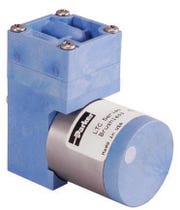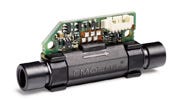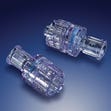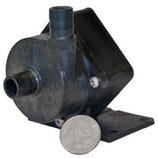September 20, 2011
 Solenoid valves for air and liquids
Solenoid valves for air and liquids
Series 204 and 304 two- and three-way solenoid valves from Parker Fluid Control are offered with a choice of tab or integrated coil and can operate in applications requiring very high pressure ratings. A family of direct-acting valves for air and liquid applications that extend to light oil, the compact components are available in both normally closed and normally open configurations. The interchangeable tab and coil comes in ac and dc versions for flexibility, and the integrated coil features a rotating conduit hub to facilitate installation. High-temperature and watertight coil designs can be supplied. Designed for maximum flow capability, the RoHS-compliant solenoid valves have orifices ranging in size from 1/32 to 5/32 in. and are manufactured with 1/8-in. NPT port connections.
Parker Fluid Control Div.
NEW BRITAIN, CT
www.parkerfluidcontrol.com
Noncontact fluid sensors
Representing an advance on a previously existing family of noncontact sensors, the OCB350-series optoelectronic fluid sensors have an automatic calibration function that can be used to compensate for the manufacturing, environmental, and system variances optical devices experience over time. This self-calibration feature makes the sensors from the optoelectronics business unit of TT Electronics suitable for medical equipment that delivers IV fluids, transfusion and infusion fluids, blood plasma, and other clear or opaque medical fluids. The sensor employs an infrared LED-phototransistor pair to determine the presence or absence of fluids in a 0.0625- to 0.25 in.-diam tube that passes through the sensor housing. It functions by using the difference in refractive properties to influence output current to signal various states, including fluid present, no fluid present, and no tube present. It can also detect the presence of air bubbles in the fluid passing through the tube. The components include the sensor mounted on a PCB with an interface cable and a series of colored LEDs to indicate various calibration states.
TT Electronics
CARROLLTON, TX
www.ttelectronics.com Bubble detector for biomedical devices
Bubble detector for biomedical devices
Sensirion AG has launched a new microflow switch to detect ultralow liquid flow rates and bubbles. Based on a digital MEMS chip, the LG01 sensor makes fluid systems more reliable by detecting liquid flows within a range of a few milliliters per minute and less. Featuring a response time below 10 milliseconds for such measurements, the sensor's output signal of either 0 or 5 V indicates whether the current flow rate is above or below the specified flow-switch level. Maximum flow rates are accepted up to 220 ml/min. The sensor's ability to perform noninvasive measurements through the wall of the straight, internal glass capillary and its PEEK fluid connectors ensure chemical resistance and biocompatibility.
Sensirion
Staefa, Switzerland
www.sensirion.com Luer-lock check valve
Luer-lock check valve
Part 80129, a pressure-activated check valve from Qosina, features a latex-free silicone diaphragm with flow direction from the female to the male luer lock. The USP Class VI-compliant low-priming valve also generates a stable cracking pressure of 8 to 10 psi and is rated to 330 psi. In addition, its polycarbonate body, which is compatible with gamma and EtO sterilization methods, gives a clear view of the fluid path.
Qosina
EDGEWOOD, NY
www.qosina.com
 Valveless dispensers and pumps for medical diagnostics
Valveless dispensers and pumps for medical diagnostics
The OEM line of chemical-resistant precision dispensers and pumps from Fluid Metering Inc. features a valveless design with just one moving part. Consisting of standard models offering a dispense range of 500 nl to 1.28 ml per revolution and custom models designed to suit application requirements, the line includes both fixed- and variable-displacement configurations. Used in medical diagnostic and analytical instrumentation applications, the units provide 0.5% CV or better and accuracy within ±1%. Stepper control kits are additionally available for developing high-precision, low-flow fluid-control systems.
Fluid Metering Inc.
SYOSSET, NY
www.fmipump.com Porous-metal flow-control components
Porous-metal flow-control components
Manufactured by Mott Corp., medical device components such as spargers and flow restrictors made from sintered porous metal are used in applications requiring efficiency, precise flows, high-temperature resistance, and resistance to aggressive chemicals. Sintered metal holds its form, functions in adverse conditions, can be subjected to rigorous sterilization procedures, and generally lasts longer than polymeric materials, according to the manufacturer. Featuring metallic integrity, the company's components do not shed particles into medical solutions. In addition, the porous parts feature labyrinths of irregular paths that perform depth filtration and capture foreign particulate matter. They also feature uniform controlled porosity, which allows precise flow rates at specified pressures. The selection of available alloys ensures that the flow components are biocompatible, compatible with other materials, and can withstand variable temperatures and corrosive environments.
Mott Corp.
FARMINGTON, CT
www.mottcorp.com
 Magnetically coupled recirculation pumps
Magnetically coupled recirculation pumps
Designed for the recirculation and transfer of fluids in medical devices, Integrity-series magnetically coupled centrifugal pumps feature components that are integrated into a compact, lightweight unit. This design, in turn, eliminates the need for motor bearings and leaves the impeller assembly as the only moving part. The magnetic-drive pumps from Gorman-Rupp Industries weigh approximately 10 oz and are driven by a 12-V brushless dc motor. With a maximum system pressure of 75 psi, they offer flow rates to 2 gpm and 12 ft of head. Standard pumps handle fluids ranging from 140° to 180°F; custom systems are available for higher temperatures. Multiple material options are offered to medical device OEMs for parts such as the pump body and adapter that come into contact with fluids. The impeller is engineered from liquid-crystal polymer, the impeller shaft from ceramic, the front thrust bearings from Teflon, and the O-rings from either EPDM or FKM.
Gorman-Rupp Industries
BELLVILLE, OH
www.gripumps.com
You May Also Like


